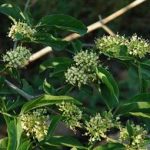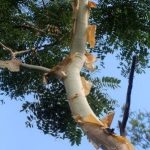TREE LIFE
April 2008
MASHONALAND CALENDAR
20 April (3rd Sunday): Kutsaga. We have been to Kutsaga twice before, once in the middle of winter and once at the height of the rainy season. This month we are planning to re-visit at an intermediate time of year and we expect to see some different trees and plants. For those who have never been, this is an interesting place with some well-protected habitats.
26 April (4th Saturday): The venue for Mark’s Walk in April is still to be decided. Please contact Mark for details of this venue a bit closer to the date. We hope to send out an email with details a few days beforehand.
MATABELELAND CALENDAR
Please contact Jean Wiley or Gill Short for details of the next Matabeleland function.
REVISED SUBSCRIPTIONS
In the March 2008 Tree Life, we announced that the subscription for the year beginning 1 April 2008 would be $6 million dollars (and higher multiples of that where people receive printed copies). This figure seemed a reasonable amount when it was set in February but it has been vastly overtaken by events and the astronomical inflation rates in the last few weeks. Accordingly, the Committee has had a re-think and we have decided that the subscription will be the price of 1 litre of petrol, payable in Zimbabwe dollars. This is the same approach as the Aloe and Cactus Society has adopted.
One problem with this, of course, is that the price is not very clearly defined – it depends on where you go to buy fuel, etc. However, we accept that this won’t be a very exact process and there may need to be some compromise.
A second decision that we have taken is that we are no longer accepting cheques. Payment must be in cash only.
I must apologize to those members who have already paid based on the lower figure. I hope that you will be understanding in these challenging times.
The higher rate subscriptions will be multiples of the base price as follows:
Email – 1 litre of petrol
Printed copy: collected – 2 litres
Printed copy: posted – 3 litres
Once again, I must emphasize strongly that we do not want to lose members as a result of these increases. Each year a number of members pay more than the norm so that the excess goes anonymously to support members who may be having financial difficulties. So, please do not be proud; talk to Terry or me.
As a reminder, payment may be made in the following ways:
1. At the Mukuvisi Woodland wildlife shop;
2. To the Treasurer, Terry Fallon, at 285 Samora Machel Avenue (tel: 778789);
3. To me, Mark Hyde, at Pentact, 3rd floor ZTA House, 95, Nelson Mandela Avenue, Harare (tel: 708758).
4. To any other Committee member.
-Mark Hyde, Chairman
A TULI EXPEDITION
Off we go! 22 December 2007. It has been a while since the Zimbabwe Flora Team (Mark Hyde, Bart Wursten and Petra Ballings) got the chance to go on a botanizing expedition, but around Christmas all parties involved were able to free themselves. After much umm-ing & aah-ing it was decided to travel to the Tuli area, tucked away in one of the most remote and untouched corners of the country. As planned, we were ready to leave Harare at about 9 o’clock. And luck was smiling in the form of bright sunshine, which had not been seen in quite some time, with December being the wettest in years.
Our plan for the first day was to get to Matobo National Park, about 480 km from Harare, at least a 6-hour drive by any standards … and certainly ignoring all the interesting vegetation on the way. We had a brief stop at the Golden Mile Motel for a quick drink and toilet break and made our first plant discovery in the form of some nicely naturalized specimens of Cannabis sativa, growing in the flower beds by the front entrance.
Just outside Kwekwe our tummies told us it was way past lunchtime. It was impossible not to take time to look at the roadside vegetation. Some of the more interesting finds included the Euphorbia-related nettle Tragic okayed, a handsome but so-far unidentified Vegan (since determined as Tooter burchellii) and a most spectacular maroon colour form of our national flower, Gloriosa superba, better known as the Flame-lily. We also included some specimens of the alien but quite unusual weed Zinnia peruviana.
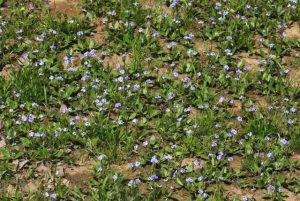
Craterostigma plantagineum specimens, mixed with some minute but lovely plants of Xerophyta humilis. Photo: Bart Wursten. Source Flora of Zimbabwe
The day passing quickly, we only got tempted to stop one more time when our eyes were caught by large patches of blue flowers covering the ground below the dry mixed Mopane-Acacia scrub. These turned out to be thousands of very pretty Craterostigma plantagineum specimens, mixed with some minute but lovely plants of Xerophyta humilis. Despite lovely, sheer endless fields of Moraea natalensis and Cycnium tubulosum, we moved on and reached Bulawayo in the late afternoon, stretched our legs, and made it to Matobo just in time before the closing of the gate. Maleme Rest Camp offered us a basic but very comfortable chalet for the first night and, as we even had the rare comfort of electricity, we downloaded our yield of photos, compiled our record lists and pressed our plants, ready for the next day of botanizing.
Matobo National Park: 23 December
After moving from the simple chalet to the relative luxury of a fully equipped cottage, we spent the morning foraging in and around the Rest Camp, which is situated right among the rocky outcrops the Matobo Hills are so famous for. Many of the Matobo specials were growing on our doorstep. Gymnosporia matobensis is a small shrub or slender tree, armed with straight needle-like spines and small oblanceolate leaves in clusters. It is a true Zimbabwe endemic, only found in the larger Matobo area. Strychnos matopensis, though not endemic (it is also known from limited areas in Mozambique and Zambia), has also been named for these hills. An elegant and handsome, climbing liana-like plant, it has interesting coiled woody tendrils and strictly opposite leaves and branches. Another distinct feature of this boulder-stacked habitat is Ochna glauca with its small blue-green leaves and red fruits. It is found in this part of Zimbabwe, only just extending across the borders into Botswana and South Africa. With its very limited distribution it would surely qualify as a near-endemic.
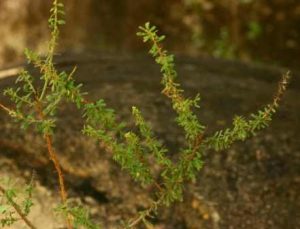
Gymnosporia matobensis, a true Zimbabwean endemic. Photo: Bart Wursten. Source: Flora of Zimbabwe
Our timing was perfect to find the pretty Turraea obtusifolia, or Small Honeysuckle-tree, in full flower as well as the magnificent citrus relative, Calodendrum capense, with its beautiful large heads of pink flowers. This type of environment is not particularly rich in ferns, but fern-lover Petra was rewarded with typical rock-lovers such as Cheilanthes involuta, Cheilanthes viridis and Doryopteris concolor.
Just outside the camp in front of the National Park offices, a small grassy vlei was alive with hundreds of butterflies, all going wild over an exotic purple-flowered Verbena weed. It is one of the typical “twin-weeds” in our flora. Two very similar species, which originally were probably well separated in their home-countries, have thrived as problem weeds after their accidental introduction. Now, both species grow together throughout the tropics, and it is very difficult if not almost impossible to distinguish Verbena bonariensis and V. brasiliensis.
The afternoon was spent at the nearby Maleme Dam. One of our main rewards was the extraordinary stapeliad Orbea caudata subsp. rhodesiana, bearing several striking but very foul-smelling flowers. These succulents attract flies as their pollinators and, as we all know, flies do not go for the pleasant odours in nature. Nearby we found Cleome oxyphylla, an attractive and uncommon relative of the widespread Purple Mouse-whiskers Cleome hirta. The campsite itself had not been slashed for some time, which suited us quite well. Another alien weed, Ambrosia maritima, got our attention. Although so far only recorded as an unusual introduction in the Eastern Division, it was very common here and thus a new record for the Western Division. Petra added another fern to her list, the uncommon Mohria lepigera with its undersides densely covered in scales. Before calling it a day we had to climb back up on the steep entrance road, where we saw another Honeysuckle-tree, Turraea floribunda. It certainly lived up to it scientific name-tag and showed us masses of flowers. These appear before the leaves have developed, which made the shrub even more striking. Over the obligatory G&T sun-downer, we contemplated that we had a fruitful and very pleasant stay in Matobo. The accommodation was well maintained and clean, and all facilities were present and in working order. The staff at Maleme were very friendly and helpful and deserve our gratitude and respect. They still showed pride in “their” National Park and have not lost motivation as would be so easy to do in these difficult circumstances.
Getting to Tuli: 24 December
The day started as one of those you don’t want to think about and just want to get over with. We had to get back to Bulawayo for some essential shopping, fuel and money. Finding the basics these days may take hours of moving from store to store and still be in vain; another currency change right over the Christmas holidays just complicated matters even more. However, we were fortunate. Just outside the city, we stopped at a small shopping centre with no more than two stores, a bottle store and a few outside vendors.
We went into one of the tiny shops, without too much hope of finding our “most wanted” items, but were amazed by our acquisition of delicious freshly baked bread rolls. Stroke of luck no. 2 was that we could pay by cheque. What we thought would be morning full of frustrations turned out to be dealt with in half an hour. We were less lucky with fuel – the queue at the Caltex garage was just too long, We did have an ample spare supply, however, which we reckoned would get us back to Bulawayo, so off we went. The landscape slowly changed from rocky hills to flat, open woodland. We gave ourselves little time to stop as most of what we saw on the way could be expected to be found at our destination. The last stretch of road was in pretty bad condition and our car started to produce some rather unhealthy grinding noises from the left front wheel, which gradually became louder and more persistent. When we finally arrived, it was with some relief but also with a definite sense of doubt whether we would be able to get back to civilization from this remote place.
Tuli: 25, 26, 27, 28 December
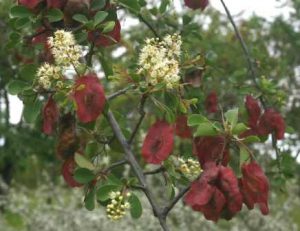
Terminalia prunioides. Photo: Bart Wursten. Source: Flora of Zimbabwe
Though marked on most maps as a true village, Tuli consists of little more than a police post, surrounded by vast expanses of near-empty scrubland, dominated by the well-known Colophospermum mopane, Terminalia prunioides and several equally undemanding cousins in the genus Commiphora. It was particularly C. tenuipetiolata, with its small, hairless 3-foliolate leaves and long slender petioles, that got our attention. It is fairly widespread in Namibia and southern Angola while a separate population has a limited distribution in northern South Africa, just entering the extreme south of Zimbabwe. A rarely seen “special” for us indeed! Two other species, C. glandulosa and C. viminea, belong to the few species in this family with apparently simple leaves. The latter also stands out with its conspicuously black-and-white banded bark, which earned it the appropriate English name Zebra-bark Corkwood.
Less than a kilometer further, the Shashe River marks what should be, by any other logic, the border with neighbouring Botswana, were it not for some bizarre historical twist carving out the “Tuli-Circle” on the opposite bank and planting the Zimbabwean flag. On the banks of the river, Wildlife & Environment Zimbabwe, long ago built a small camp, where members and non-members can stay to enjoy the natural beauty and tranquility of the area in shade of majestic riverine trees like Ficus sycamorus, Faidherbia albida and Xanthocercis zambesiaca. This last species belongs to the large and well-known pod-bearing family Fabaceae but apparently fills the role of the proverbial exception that supposedly proves the rule, because it has fleshy, berry-like fruits that do not resemble pods in any way whatsoever.
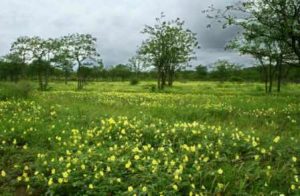
Carpets of yellow Tribulus zeyheri. Photo: Petra Ballings. Source: Flora of Zimbabwe
Most of the year the soils appear to be a dry and barren resort, suitable only to hardy succulents like Sesamothamnus lugardii, Euphorbia cooperi, Aloe chabaudii, Stapelia gigantea or the grotesque Adenia spinosa. However, an often brief and meagre season of rains temporarily transforms the earth into a colourful garden of eager and short-lived flowers, resembling some painting by Van Gogh on one of his wilder days. Carpets of yellow Tribulus zeyheri are mixed with the bright orange-red bells of Hermannia kirkii, deep pink heads of Indigofera holubii and many others. Tribulus zeyheri shares the prostrate habit, the imparipinnate leaves and the hard 3-thorned fruits with its close relative, the well-known and widespread T. terrestris, or Devil’s thorn. T. zeyheri has much larger and more attractive yellow flowers and is only very locally common in the far south of the country. The spiny fruits of both species have the persistent habit of attaching themselves to animals’ hooves, soles of boots and even car tyres. This aids dispersal of the seeds and also serves as a very good warning not to go botanizing barefoot. Most of the time was spent botanizing close around the camp. We walked along the river, in the grasslands, climbed a few low hills, walked through dry riverbeds and found it extremely fascinating to be in an area so different from what we, coming from Vumba, are used to.
The wetter periods during our stay mostly involved moving the furniture around the many leaks in the roof, while helping hands were offered in getting our car back in shape by the friendly and helpful Johan, who, with his wife Mary, manages one of the hunting camps across the river. They were stranded with us in camp, their car being stuck on the other side of the unusually flooded and impassable Shashe River. Johan was definitely more mechanically inclined than us botanists, and he had many hours of fun taking the front wheel apart, applying some frightening “bush-mechanics’ including using an old concrete nail to temporarily solve our problem….Don’t ask!
Back to Bulawayo: 29 December
A rather suspenseful day of travel since we could only hope our car would make it back to Bulawayo with all four wheels attached … especially since it was more overloaded than ever. Although it should have been a bit lighter after eating our way through some of the supplies, we were probably carrying double the weight of the trip down. Johan and Mary still had their car stranded on the other side of the Shashe, which was showing no signs of becoming passable. After their help with getting our car movable again, we decided we could return the favour by taking them and their luggage with us to Bulawayo. Johan appeared to be confident his craftsmanship with our wheel would hold and reassured us that, if there were a problem, he had some tools at hand. He also showed us an alternative route, which avoided most of the horrible corrugations we had endured on the way in. This itinerary actually showed us some slightly different, more rocky places and yielded some more interesting plant-records including a stunning specimen of Stapelia gettliffei with large starfish-like flowers fringed with long purple hairs. Interestingly, one of the more fascinating discoveries was an attractively violet-flowered but horrendously spiny species of Central American cactus we identified as Opuntia fulgida. Though not recorded as such before, it was definitely well-naturalized in the area and even becoming worryingly invasive in places.
And, yes, we did make it, reaching Bulawayo with all four wheels still firmly in place. We safely delivered Johan and Mary at their destination and made our way to Francis Day, who very kindly took us in from the streets of Bulawayo.
Bulawayo: 30 & 31 December
We did get a bit stranded … with still no diesel at Caltex and great shortages of money. Where else but in Zimbabwe? A day of enforced relaxation was called for and finally, at last, through unpublishable sources, we managed to find some 60 liters of indispensable liquid. After clearing that logistical headache, we decided that an outing to the Hillside Dams was in order. It is an interesting mixture of somewhat neglected and overgrown rock-gardens and indigenous rocky woodland surrounding two old water-supply dams. The area is being restored into a safe and pleasant recreational park by some very admirable Bulawayo citizens. (For more information on this excellent project, see Tree Life No. 333 and check out their website: https://www.hillsidedams.com/.)
The last evening of this rather eventful year was spent on the veranda of Francis Day’s Bulawayo home, listening to frogs, crickets and the occasional distant fireworks, while dishing out on some delicious snacks and contemplating what the coming year will have in store for us!
-Petra Ballings, Bart Wursten
INVASIVE ALIEN PLANTS IN SOUTHERN AFRICA, PT. 2
In this second in the series on invasive aliens, Lesley Henderson discusses leguminous plants, one of the families of invasive alien plant species that occur widely in southern Africa. I have made some minor editorial additions. –Ed.
The Legumes (Fabaceae)
Thirty-six (18%) of the 198 species listed as declared plants in South Africa belong to the Fabaceae, or legume family. All these plants are invasive and regarded as harmful to natural resources.
Acacias
The acacias are the most numerous, with 13 listed species. All are from Australia and with one exception, A. paradoxa, differ from African acacias—they have no spines or thorns. They can be divided into two distinct groups, one with bipinnate leaves, and the other with phyllodes. A phyllode appears to be a simple, undivided leaf, but is actually a leaf-like petiole with no blade. All the listed alien acacias are evergreen, whereas most of the indigenous species are deciduous.
The alien acacias account for a very large proportion of all plant invasion in South Africa. They are important invaders of all the major vegetation types, except for those in the most arid areas.
The most widespread and abundant acacias are Acacia mearnsii, black wattle; A. cyclops, red eye/rooikrans; and A. saligna, Port Jackson. Black wattle has invaded the widest range of vegetation types and is the most widespread riverine invader. Common in Zimbabwe’s Eastern Highlands, it also occurs almost continuously from Louis Trichardt in Limpopo Province of South Africa down the eastern seaboard to Cape Town, a distance of about 2,500 km. Rooikrans stretches along the entire coastline from Port Nolloth in the northwest to beyond East London in the east, a distance exceeding 2,000 km. Port Jackson stretches along the Cape coastline from Saldanha Bay in the west to the Kei River in the east. Port Jackson and rooikrans are important invaders of fynbos vegetation. Successful biological control of Port Jackson, using an introduced gall-forming rust fungus [Ed: the subject of a forthcoming article], has greatly reduced the densities of populations and in the long term should provide complete control of this invader.
Acacia dealbata, silver wattle, and A. decurrens, green wattle, are most abundant in the grassland regions from the Eastern Cape northwards. A. longifolia, long-leaved wattle, and A. melanoxylon, blackwood, are most abundant along the Cape coastal belt stretching from Cape Town to Port Elizabeth; they also extend northwards as far as Limpopo Province. Blackwood is an important forest invader.
A. pycnantha, golden wattle, is an invader of fynbos, mainly in the Western Cape. Gall-forming wasps, introduced for the biocontrol of long-leaved and golden wattles, have become well established, reducing flowering and seed-production.
Species of minor importance, but becoming increasingly invasive, are A. baileyana, Bailey’s wattle, A. podalyriifolia, pearl acacia, A. implexa, screw-pod wattle, and A. elata, pepper tree wattle. These species have been planted mainly as garden ornamentals or windbreaks rather than on a grand scale in plantations. Pepper tree wattle is mainly naturalised in the Western Cape where it is encroaching on fynbos and forest. Bailey’s wattle and pearl acacia are spreading wherever they have been planted. Screw-pod wattle is invading watercourses and fynbos in the Western Cape.
Acacia paradoxa, kangaroo thorn, is a thorny shrub only known in southern Africa from one location: Devil’s Peak on Table Mountain. It is listed under the Australian Noxious Weeds Act, which is an indication of its weed potential in Africa.
Other Genera
Albizia lebbeck and A. procera, lebbeck and false lebbeck, are invasive in warm and humid coastal areas. They are of tropical Asian origin and are large, spreading trees up to 15 m tall.
Alhagi maurorum, camel thorn bush, is a thorny, almost leafless bush, invading agricultural croplands and river-banks in dry areas. Bauhinia purpurea and B. variegata, butterfly orchid and orchid trees, are Asian trees invading the subtropical and tropical savanna regions. They are popular ornamentals, flowering and seeding prolifically.
Caesalpinia decapetala, Mauritius or Mysore thorn (after Mysore Province in India), is a very tough and spiny, scrambling shrub or climber, forming dense thickets. It invades forest margins, plantations, and watercourses. Of tropical Asian origin, it is restricted to the subtropical and tropical eastern seaboard and adjacent interior of South Africa.
Cytisus monspessulanus (Genista monspessulana), Montpellier broom, is a Mediterranean shrub, invading fynbos on Table Mountain. Cytisus scoparius (Genista scoparia), Scotch broom, is an almost leafless shrub with bright yellow flowers, mainly invading grassland and forest margins on the lower slopes of the Drakensberg in KwaZulu-Natal. Gleditsia triacanthos, honey locust, is a large, spreading tree, armed with formidable three-branched spines. It is of North American origin. It has been cultivated for its edible pods, honey production, shade, and for donga reclamation. Now it is invading river-banks, drainage lines, and other moist sites in southern Africa.
Leucaena leucocephala, leucaena or giant wattle, possibly of Mexican origin, invades mainly the subtropical coastal and lowveld areas of southern Africa. It is also a highly valued plant for fodder and woodlots and has been introduced as a fodder tree.
Mimosa pigra, giant sensitive plant, is believed to be of tropical American origin, but is now pan-tropical. It has long been known in one area of KwaZulu-Natal, where it appears not to be a problem; it is, however, invasive and has caused much concern further north at Tzaneen along the Letaba River. This species has invaded extensive tracts of floodplains in Australia.
Paraserianthes lophantha, stink bean, is an Australian tree that has invaded moist sites in forest in the Western and Eastern Cape. It resembles a large-leaved black wattle.
Prosopis spp., mesquite, introduced from the southwestern USA and Mexico, have invaded the arid interior of South Africa. Their preferred habitat is drainage lines and river-banks, which are the most fertile sites in these regions. They are cultivated for shade, firewood, and for their pods, which are fed to livestock. However, dense thickets not only produce fewer pods, but also prevent access to livestock. Biocontrol using seed-feeding bruchid beetles has the potential to greatly reduce the development of further infestations.
Pueraria lobata, Kudzu vine, is a vigorous, long-running vine that can reach heights of 18 m. It invades forest margins and riverbanks. In the region, it is so far only known from a few sites in Mpumalanga and Limpopo Province in South Africa. Introduced into the southern USA as cattle fodder and for erosion control, kudzu is such a dense climber that it kills the supporting trees.
Robinia pseudoacacia, black locust [seen on a recent Tree Society outing], is a North American thorny tree that forms dense suckering thickets, particularly along watercourses. Senna bicapsularis (Cassia bicapsularis) and Senna pendula var. glabrata (Cassia coluteoides) are rambling ornamental shrubs or climbers from South America. They are invasive in the subtropical and tropical savanna regions, particularly along watercourses. Senna didymobotrya (Cassia didymobotrya), peanut butter cassia, is indigenous to central Africa. It has been widely planted in southern Africa as an ornamental and hedge plant, particularly around animal kraals. It is poisonous.
Sesbania punicea, red sesbania, is an ornamental South American shrub or small tree that has widely invaded watercourses throughout South Africa. A very successful biocontrol programme, using three species of introduced beetles, is effectively maintaining this species at population levels that are no longer problematic.
Spartium junceum, Spanish broom, is invading urban open space, wasteland, and fynbos in the Western Cape. It is an almost leafless shrub or small tree with bright yellow flowers. A native plant of the Mediterranean, it is now invading a similar climatic region at the tip of Africa.
Tipuana tipu, tipuana, is a large, spreading South American tree that is invading watercourses in the savanna regions.


